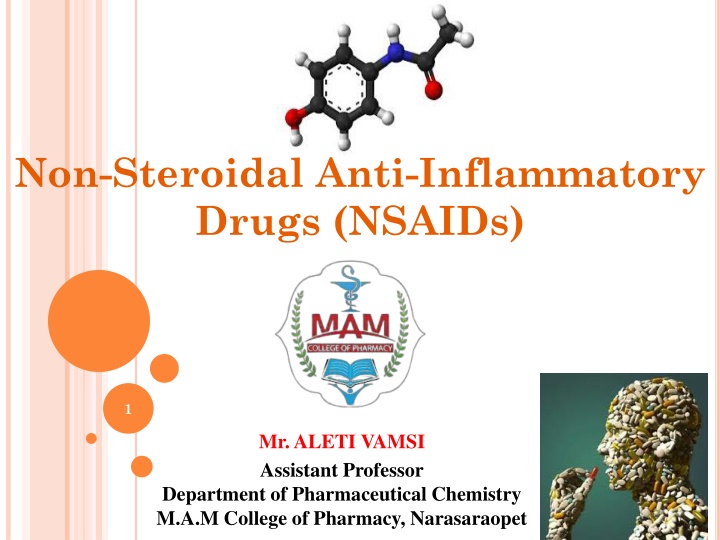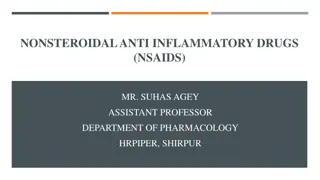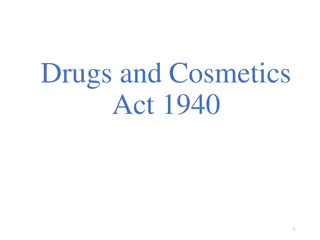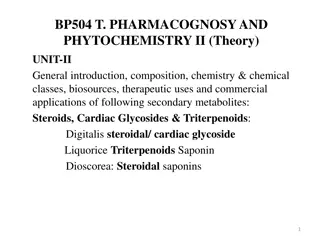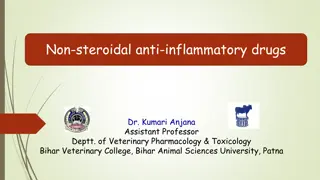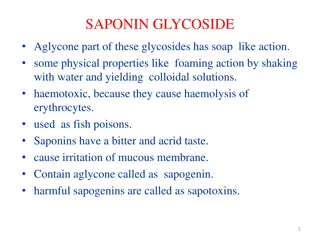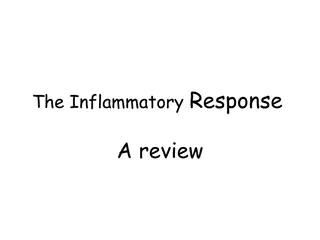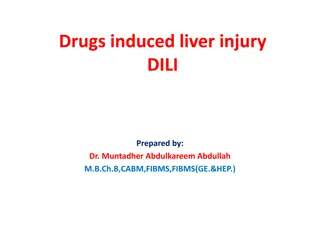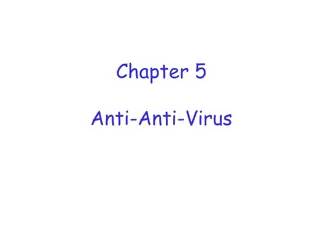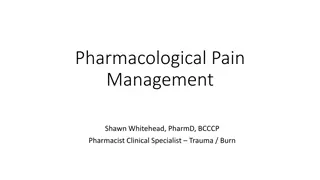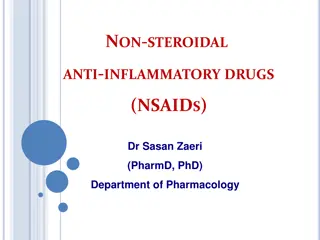Non-Steroidal Anti-Inflammatory Drugs (NSAIDs)
NSAIDs are non-narcotic drugs with analgesic, antipyretic, and anti-inflammatory properties. They are used to treat various types of pain but can have side effects. On the other hand, opioid analgesics, derived from opium, are potent prescription medicines for moderate to severe pain. The classification of opioids includes natural opium alkaloids, semi-synthetics like heroin, and synthetic opioids such as phenylpiperidines and phenyl-heptylmines.
Download Presentation

Please find below an Image/Link to download the presentation.
The content on the website is provided AS IS for your information and personal use only. It may not be sold, licensed, or shared on other websites without obtaining consent from the author.If you encounter any issues during the download, it is possible that the publisher has removed the file from their server.
You are allowed to download the files provided on this website for personal or commercial use, subject to the condition that they are used lawfully. All files are the property of their respective owners.
The content on the website is provided AS IS for your information and personal use only. It may not be sold, licensed, or shared on other websites without obtaining consent from the author.
E N D
Presentation Transcript
Non-Steroidal Anti-Inflammatory Drugs (NSAIDs) 1 Mr. ALETI VAMSI Assistant Professor Department of Pharmaceutical Chemistry M.A.M College of Pharmacy, Narasaraopet
NSAIDs: NSAIDs are drugs with analgesics (pain reducing), anti pyretic (fever reducing), reduce inflammation (redness and swelling). 2/13/2025 NSAIDs are non norcotic drugs. They are associated with no. of side effects. The common side effects are nausea, diarrehea, constipation, vomiting, rashes, dizziness etc The most serious side effects are kidney failure and liver failures. Used to treat Headaches, painful periods, toothache and sports injuries. 2
Types of Pains: 2/13/2025 4
Selective COX-2 Inhibitors These drugs acts as anti inflamatory agents by directlly inhibiting COX2 enzyme. These drugs reduce the risk of peptic ulcers. After several COX 2 inhibitors for marketing, data from clinical trails revealed that, these drugs are cause incresed heart attack and strokes Some of the agents are taken out from the market 2/13/2025 COX-2 inhibitors do not contain carboxylic acid groups. They have different chemical structures 5
Selective COX-2 Inhibitors - Celecoxib Celecoxib is in a class of NSAIDs called COX-2 inhibitors It is used to relieve pain, swelling. 2/13/2025 Synthesis of Celecoxib: ethyl trifluoroacetate and methylacetophenone react to give 4-methyltrifluoroacetyl benzophenone. Treatment with 4- hydrazine benzensulfonamide results in closing of pyrazole ring to give celecoxib. 6
OPIOID ANALGESICS The opioid analgesics which are prescription only medicines that are very potent, being chemically related to morphine. Opioid analgesics are prescribed for moderate to severe pain 2/13/2025 OPIUM, the greek name for poppy juice. Is obtained from the juice of the papaver somniferum. Extraction of Poppy to Opioids: 7
Opoids Classification 1. Natural Opium Alkaloids: Morphine and Codeine 2. Semi-synthetic: Diacetylmorphine (Heroin) and Pholcodeine 3. Synthetic Opioids: Phenylpiperidines: Pethidine (Mepiridine) and its congeners Diphenoxylate 2/13/2025 and Loperamide Fentanyl and its congeners sufentanil, remifentanil and alfentanil Phenyl-heptylmines: Methadone and congeners like Propoxyphene and Dextropropoxyphene Benzomorphans: Pentazocine Morphinan compounds and congeners: Levorphanol and Butorphanol 8
2/13/2025 10
2/13/2025 11
Mechanism: 2/13/2025 12
2/13/2025 13
Pentazocine is a mixed agonist/antagonist. 2/13/2025 Synthesis: 14
ANTITUSSIVE ANTITUSSIVE 2/13/2025 15
DEFINITION ANTITUSSIVE:- A drug that suppresses coughing possibly by reducing the activity of the cough center in the brain 2/13/2025 CLASSIFICATIONOFCOUGH Acute:- less than 3 weeks. Sub-Acute:- between 3-8 weeks. Chronic:- longer than 8 weeks. 16
CLASSIFICATION CENTRALLY ACTING ANTITUSSIVE:- 1) The centrally acting antitussives consists primarily of the phenanthrene alkoloid of opium. These drugs selectively act on the medullary centre to suppress the cough reflex. Narcotic antitussive:- Codeine Hydrocodone Oxycodone Non-narcotic antitussive:- Dextromethorphan Noscapine Propoxyphene 2/13/2025 17
2) PERIPHERALLY ACTING ANTITUSSIVE:- Mucosal anaesthetics:- Benzonatate: aneasthetic tetracaine. Chlophedianol Hydrating agents:- Steam Aerosols Miscellaneous:- Bromhexine its structurally releted local 2/13/2025 18
2/13/2025 THANKYOU THANK YOU 19
